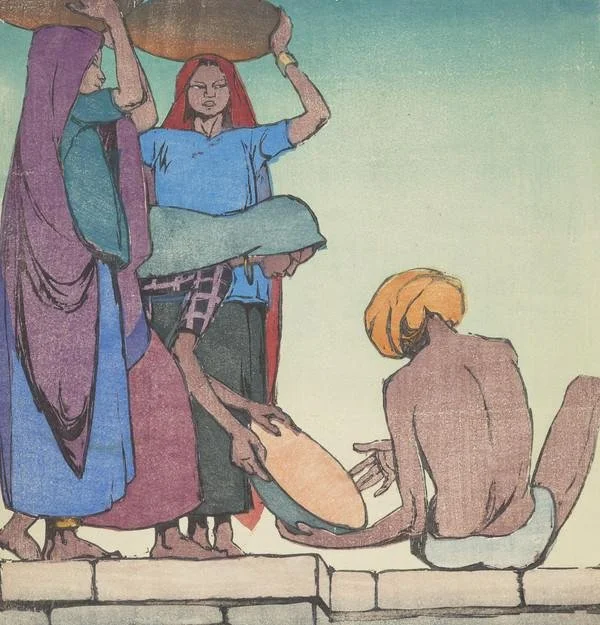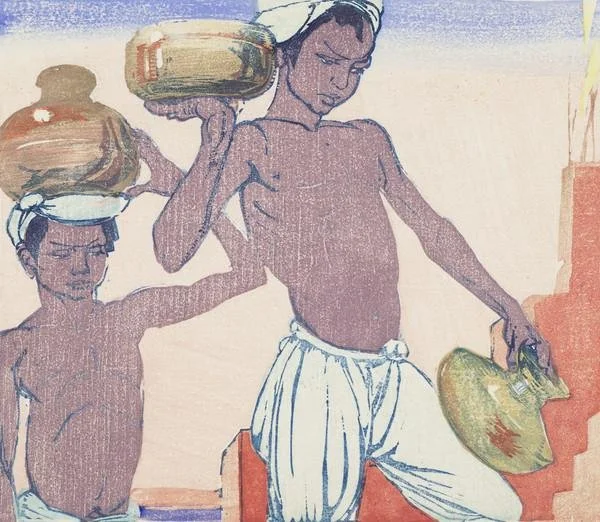Mabel Royds in India at the Scottish National Gallery
A display of five of Mabel Royds’ sketches from her time in India are currently on view at the National Gallery in Edinburgh.
There’s such delicacy to Royds’ drawing, a real sense of time slowing down. You can almost imagine her sitting quietly by the Ganges, sketchbook in hand, watching the world go by and choosing which small, everyday moment to capture forever.
After poring over the works (and wishing there had been more — the National Gallery actually holds over thirty of her pieces), I went along to an excellent talk by Senior Curator Charlotte Topsfield. It was full of fascinating detail about Royds’ life and practice, and I came away with a new appreciation for how adventurous she was.
On the Docks, about 1914-17, pencil and pastel on paper
Born in 1874, Mabel Royds learnt drawing at Queen’s School in Chester before heading to the Slade School in London in 1892. At that time, women at the Slade were allowed to draw still lifes — but not the male nude. Even so, Royds made the most of what she could study and built the strong technical foundation that would underpin her later work.
By 1902 she’d joined the Women’s International Art Club and moved to Paris, exhibiting the following year at the Salon d’Automne — a huge achievement for any artist, never mind a young woman working abroad at the turn of the century. In Paris, she became a studio assistant and friend to Walter Sickert, one of the leading figures of the Camden Town Group.
House-top, about 1920, colour woodcut on paper
Royds never stayed still for long. In 1905 she moved to Toronto to teach painting and drawing, and just a few years later she was in Scotland, joining the staff at Edinburgh College of Art. Around this time she fell in love with Japanese woodblock printing — an art form that would shape her most recognisable work. By 1911 she was teaching the technique herself, and that same year she married fellow printmaker Ernest Stephen Lumsden.
The couple spent their honeymoon touring India, returning there in 1915 after Lumsden was rejected for wartime military service. The following year they travelled to Ladakh, in the Karakoram mountains in north-west India, visiting Buddhist monasteries and sketching the people and landscape. Royds was interested in everyday life, especially the rituals along the Ganges, sketching constantly, she captured fleeting moments with warmth and sensitivity. Monks she met reportedly offered her accommodation and gifts in exchange for her drawings.
When she returned to Scotland in 1920 to give birth to her daughter, her husband remained in India with the army. Three years later, she resumed teaching at Edinburgh College of Art part-time, whilst continuing to print and paint from home.
The 1920s were full of activity: Royds exhibited widely, painted church ceilings and memorial chapels, and continued refining her craft.
When the Great Depression hit in the 1930s and etching sales collapsed, she turned her attention to flowers. Whether that shift was practical or creative — or both — her vibrant flower prints became her most celebrated works. She experimented with colour, layering, and texture, producing prints that still feel fresh and modern today.
Water Carriers, Benares, about 1920, colour woodcut on paper
Through her printmaking, Royds transformed her observations — whether of a flower, a festival, or a fleeting gesture — into bold, dynamic designs. She exhibited across the UK and Ireland right up until her death in 1941, and though research into her work continues, what’s already clear is that she forged an independent and distinctive career at a time when very few women could.
Mabel Royds in India is on display at the National Gallery, Edinburgh until 28th September. More information here.




